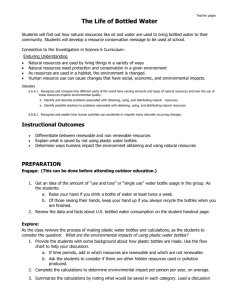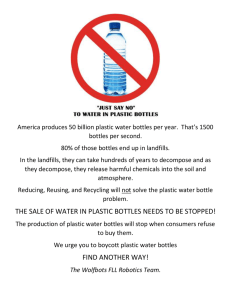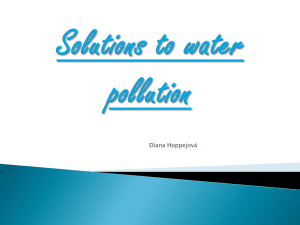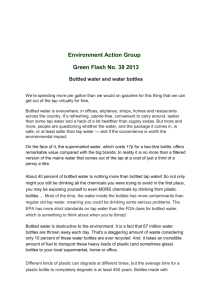bottled water and energy a pacific institute fact sheet
advertisement
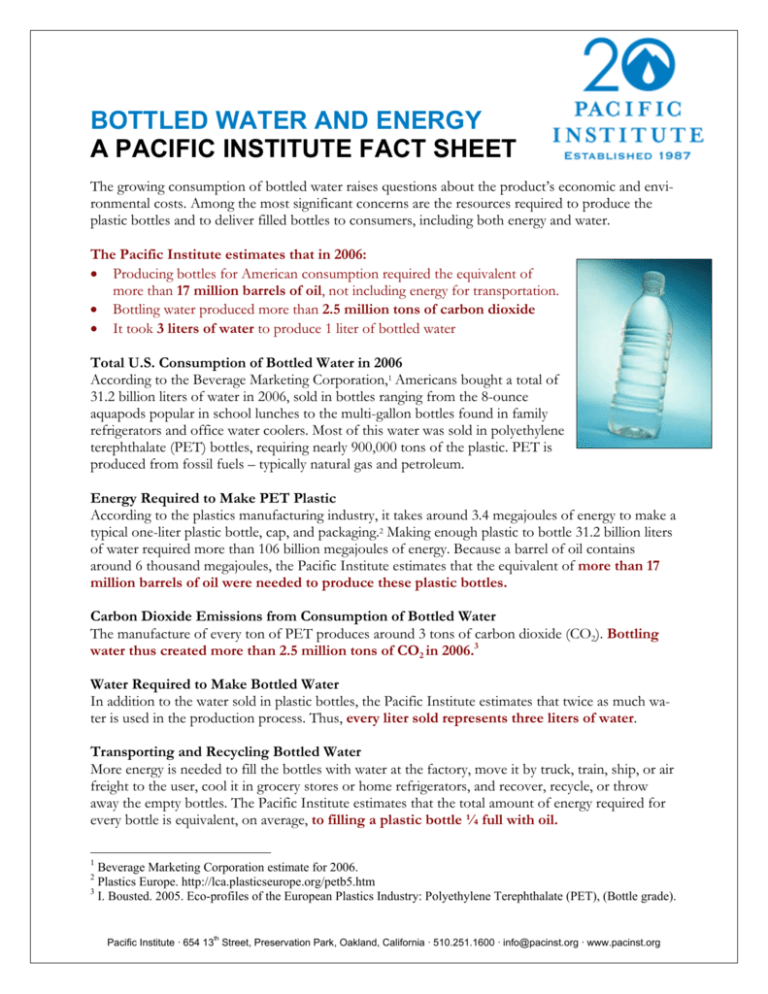
BOTTLED WATER AND ENERGY A PACIFIC INSTITUTE FACT SHEET The growing consumption of bottled water raises questions about the product’s economic and environmental costs. Among the most significant concerns are the resources required to produce the plastic bottles and to deliver filled bottles to consumers, including both energy and water. The Pacific Institute estimates that in 2006: • Producing bottles for American consumption required the equivalent of more than 17 million barrels of oil, not including energy for transportation. • Bottling water produced more than 2.5 million tons of carbon dioxide • It took 3 liters of water to produce 1 liter of bottled water Total U.S. Consumption of Bottled Water in 2006 According to the Beverage Marketing Corporation,1 Americans bought a total of 31.2 billion liters of water in 2006, sold in bottles ranging from the 8-ounce aquapods popular in school lunches to the multi-gallon bottles found in family refrigerators and office water coolers. Most of this water was sold in polyethylene terephthalate (PET) bottles, requiring nearly 900,000 tons of the plastic. PET is produced from fossil fuels – typically natural gas and petroleum. Energy Required to Make PET Plastic According to the plastics manufacturing industry, it takes around 3.4 megajoules of energy to make a typical one-liter plastic bottle, cap, and packaging.2 Making enough plastic to bottle 31.2 billion liters of water required more than 106 billion megajoules of energy. Because a barrel of oil contains around 6 thousand megajoules, the Pacific Institute estimates that the equivalent of more than 17 million barrels of oil were needed to produce these plastic bottles. Carbon Dioxide Emissions from Consumption of Bottled Water The manufacture of every ton of PET produces around 3 tons of carbon dioxide (CO2). Bottling water thus created more than 2.5 million tons of CO2 in 2006.3 Water Required to Make Bottled Water In addition to the water sold in plastic bottles, the Pacific Institute estimates that twice as much water is used in the production process. Thus, every liter sold represents three liters of water. Transporting and Recycling Bottled Water More energy is needed to fill the bottles with water at the factory, move it by truck, train, ship, or air freight to the user, cool it in grocery stores or home refrigerators, and recover, recycle, or throw away the empty bottles. The Pacific Institute estimates that the total amount of energy required for every bottle is equivalent, on average, to filling a plastic bottle ¼ full with oil. 1 Beverage Marketing Corporation estimate for 2006. Plastics Europe. http://lca.plasticseurope.org/petb5.htm 3 I. Bousted. 2005. Eco-profiles of the European Plastics Industry: Polyethylene Terephthalate (PET), (Bottle grade). 2 th Pacific Institute · 654 13 Street, Preservation Park, Oakland, California · 510.251.1600 · info@pacinst.org · www.pacinst.org

